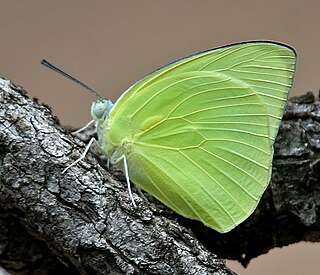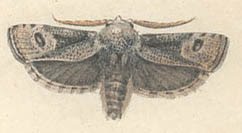
Catopsilia pomona, the common emigrant or lemon emigrant, is a medium-sized pierid butterfly found in Asia, Cambodia and parts of Australia. The species gets its name from its habit of migration. Some early authors considered them as two distinct species Catopsilia crocale and Catopsilia pomona.

Lichenaula tuberculata is a moth of the family Xyloryctidae. It is endemic to Australia, more specifically the Australian Capital Territory and New South Wales.

Lichenaula lichenea is a species of moth of the family Xyloryctidae. It is known in Australia from the Australian Capital Territory, New South Wales and Queensland.

Metacrias strategica is a species of moth in the family Erebidae. This species is endemic to New Zealand where it is known from the southern part of the South Island. The female of the species is flightless and pale brown, grey or yellowish-brown in colour where as the male is brightly coloured and flies during the day.

Heterocrossa gonosemana is a species of moth in the family Carposinidae. It is endemic to New Zealand.
Metasia aphrarcha is a moth in the family Crambidae. It was described by Edward Meyrick in 1887. It is found in Australia, where it has been recorded from Western Australia.
Metasia strangalota is a moth in the family Crambidae. It was described by Edward Meyrick in 1887. It is found in Australia, where it has been recorded from New South Wales.
Pycnarmon radiata is a moth in the family Crambidae. It was described by William Warren in 1896. It is found in China and India.
Stemorrhages marthesiusalis is a moth in the family Crambidae. It was described by Francis Walker in 1859. It is found in India, Sri Lanka and Australia, where it has been recorded from Queensland.

Sufetula hemiophthalma is a moth in the family Crambidae. It was described by Edward Meyrick in 1884. It is found on the Cook Islands, French Polynesia, Fiji and Australia, where it has been recorded from New South Wales and Queensland.
Catoryctis eugramma is a moth in the family Xyloryctidae. It was described by Edward Meyrick in 1890. It is found in Australia, where it has been recorded from New South Wales and Queensland.

Cryptophasa delocentra is a moth in the family Xyloryctidae. It was described by Edward Meyrick in 1890. It is found in Australia, where it has been recorded from New South Wales and Queensland.
Cryptophasa nigricincta is a moth in the family Xyloryctidae. It was described by Turner in 1898. It is found in Australia, where it has been recorded from Queensland.

Cryptophasa albacosta, the small fruit tree borer, is a moth in the family Xyloryctidae. It was described by John Lewin in 1805. It is found in Australia, where it has been recorded from New South Wales, Queensland, South Australia, Tasmania and Victoria.

Cryptophasa irrorata is a moth in the family Xyloryctidae. It was described by John Lewin in 1805. It is found in Papua New Guinea and Australia, where it has been recorded from the Australian Capital Territory, New South Wales, Queensland and South Australia.
Echiomima mythica is a moth in the family Xyloryctidae. It was described by Edward Meyrick in 1890. It is found in Australia, where it has been recorded from New South Wales and Queensland.
Hypertropha thesaurella is a moth in the family Depressariidae. It was described by Edward Meyrick in 1880. It is found in Australia, where it has been recorded from Queensland and New South Wales.
Odites ricini is a moth in the family Depressariidae. It was described by Henry Tibbats Stainton in 1859. It is found in India.
Agriophara velitata is a moth in the family Depressariidae. It was described by Thomas Pennington Lucas in 1900. It is found in Australia, where it has been recorded from Queensland.
Imma autodoxa is a moth in the family Immidae. It was described by Edward Meyrick in 1886. It is found on Fiji.








